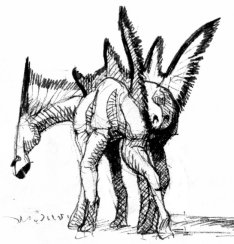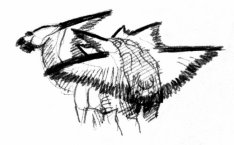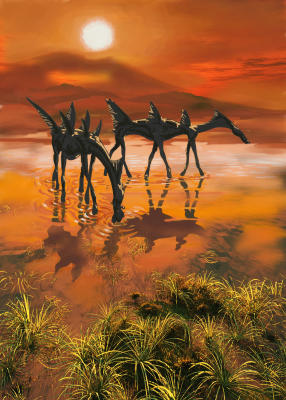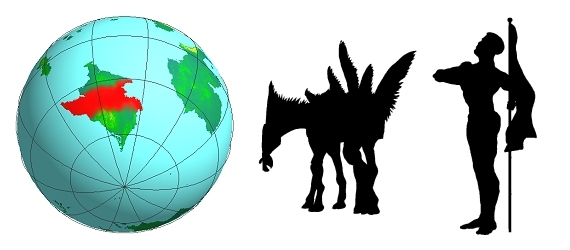


|
It is a pity that the jingoes* in this picture are shown against the light, because their main feature, having back sails, is now not well visible. Another thing wrong with this picture is that it is hard to see how the six legs work together. Jingoes follow one of two major solutions to the problem of weight distribution in hexapods. They have opted for the 'centred' solution: the bulk of their weight is supported by the middle pair of legs, that are not just stouter than the other pairs, but also further apart. This also helps to avoid the legs from touching one another while walking. |
|
The back sails are flaps of white skin with a black hair fringe at their tail ends. Jingoes use these skin flaps to signal to other jingoes. They can raise and lower the flaps by pairs or all together. The aft pair can move from the side to the top. In combination, a wide variety of signals can be transmitted, all of which apparently mean something to other jingoes. If you take into account that their neck is also supplied with a similar sail, running from an occipital spike to the neck itself, you may appreciate the scope of signals that jingoes can convey. It is of course also possible that there are in truth only a limited number of messages, and that jingoes don't have actually much to say except 'hey, it's me!'. |


|

|
The jingo painting is undergoing reconstruction. Shown here is an early planning stage. The painting was digitised, and their place in the design was changed. Shadows will have to be added, and a bit of foreground to make the design less flat and twodimensional. At this stage eveything may still change, though. |
|
Jingoes are plains animals with an extensive and complex social network. Like many other large herbivores, their sex may change in the course of life, in part depending on their social status. Of course, the relationship between social status and sex goes two ways, meaning life is complex. |

|